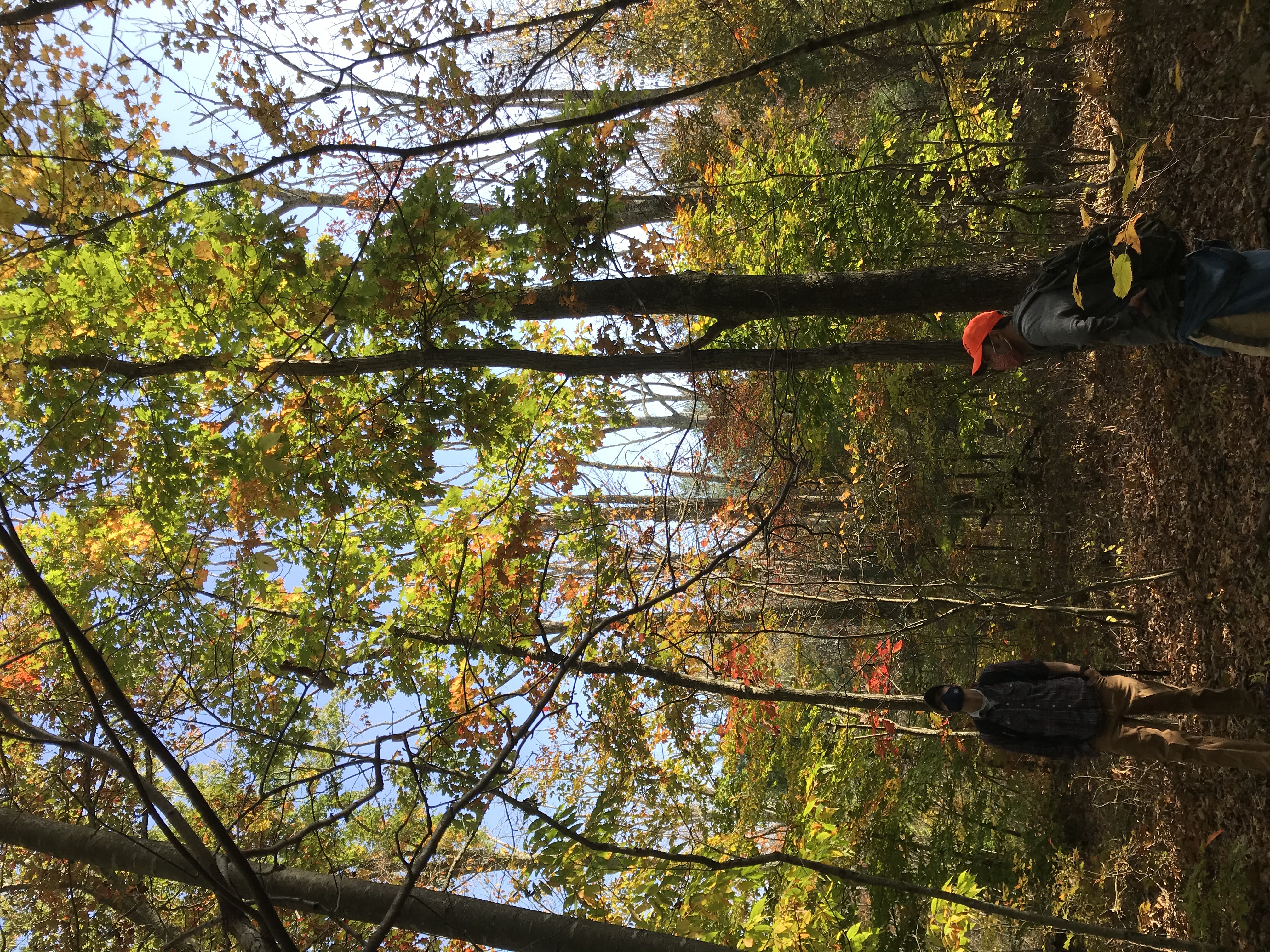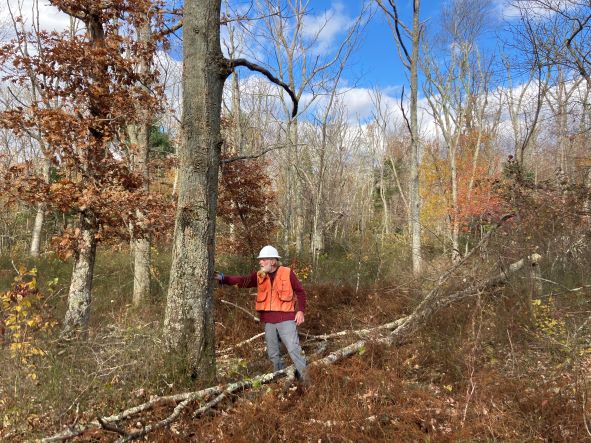A team of natural resource managers from the Connecticut Department of Energy and Environmental Protection and several local organizations teamed up with regional scientists from the University of Connecticut and the Northern Institute of Applied Climate Science for a virtual workshop in October 2020 to develop the study design for the ASCC project site. The team developed a set of Desired Future Condition statements (DFCs), Objectives, and Tactics for each climate adaptation trajectory (resistance, resilience, transition). These DFCs, objectives, and tactics also provided the foundation for the discussions at the DeCoppet Preserve replicate of this affiliate ASCC site led by the University of Rhode Island and the Rhode Island Department of Environmental Management. Goals for the three treatments are summarized briefly below:
RESISTANCE

maintain relatively unchanged conditions over time
Management Goals:
- Maintain current composition and structure with oak dominance with current components of hickory, but also including shade tolerant species and minor species such as hemlock
- Maintain a fully-stocked stand
- Initiate regeneration that reflects the current species composition
- Maintain or reduce impacts from forest pests, insects, disease, and invasives
- Reduce competing understory vegetation to promote regeneration
- Protect key ecological and physical characteristics of the site
- Retain habitat features, such as dead wood, to support the current assemblage of birds and other wildlife
Strategies & Approaches:
- Locate, treat, and remove invasive plant populations and reduce the abundance of other competitive vegetation prior to any harvest treatments
- Implement a 3-stage shelterwood harvest:
- Preparatory treatment to tend any regeneration that has established in the most recent disturbance event, create opportunities to establish new regeneration for oak and hickory, and increase crown space around residual trees to increase vigor and value
- Shelterwood cut to reduce stand density and facilitate growth of new regeneration
- Overstory removal (partial or complete) at 20-30 years into the future to maintain conditions suitable for the desired regrowth
- Create reserves within the shelterwood to protect key features:
- Areas with rare species, sensitive sites, or recreational areas for reserves
- Areas that are topographically sheltered (less vulnerable to windthrow)
- Retain wildlife trees and standing dead trees for habitat when they do not pose a safety hazard
- Use hazardous trees to create dead downed wood when possible
RESILIENCE

allow some change in current conditions, but encourage eventual return to original conditions
Management Goals:
- Increase species and structural diversity characteristic of this forest community to provide multiple pathways of recovery from disturbance
- Increase the abundance of historically-native species that are adapted to future climate conditions and increased climate variability
- Create multiple age classes that are spatially heterogeneous
- Reintroduce fire as a natural disturbance when possible and increase the resilience of the forest to wildfire
- Improve health and vigor of forest to a variety of insects and diseases (e.g, gypsy moth, forest caterpillar, etc.) and to reduce risk from drought
- Reduce impacts from nonnative invasive plants and undesirable competing vegetation to facilitate future-adapted tree species
Strategies & Approaches:
- Locate, treat, and remove invasive plant populations and reduce the abundance of other competitive vegetation prior to or in conjunction with any harvest treatments
- Consider the use of prescribed fire or fire surrogates (e.g., flame torches) to control of invasive and competing vegetation and encourage oak and hickory
- Create patch cuts to enhance advance regeneration and create light and growing conditions suitable for additional natural regeneration and planting
- Openings should be at least ½ acre to allow for full sun in the center and a gradient of light conditions
- Consider larger openings up to 2-5 acres in size where opportunities allow
- Patches can be centered on areas of gypsy moth mortality when these conditions are present
- Conduct a low thinning between patches to reduce density in these areas and increase the windfirmness of residual trees
- Plant American chestnut and other tree species that were historically present and are expected to be adapted to future conditions
- Protect planted and natural regeneration from deer herbivory
- Retain wildlife trees and standing dead trees for habitat when they do not pose a safety hazard
- Use hazardous trees to create dead downed wood when possible
TRANSITION
actively facilitate change to encourage adaptive responses

Management Goals:
- Alter the forest community composition to an oak-hickory forest dominated by that contains a novel assemblage of future-adapted species
- Increase overall tree species diversity with a substantial component of native and novel future-adapted species and genotypes that are windfirm and drought-tolerant
- Create diverse canopy cover conditions over space and time that is heterogeneous for regeneration
- Promote age class diversity and structural complexity
- Increase proportion of stand in early successional stage of development, at least temporarily
- Improve health and vigor of forest to a variety of insects and diseases (e.g, gypsy moth, forest caterpillar, etc.) and to reduce risk from drought
- Reduce impacts from nonnative invasive plants and undesirable competing vegetation to facilitate future-adapted tree species
Strategies & Approaches:
- Locate, treat, and remove invasive plant populations and reduce the abundance of other competitive vegetation prior to or in conjunction with any harvest treatments
- Consider the use of prescribed fire or fire surrogates (e.g., flame torches) to control of invasive and competing vegetation and encourage oak and hickory
- Create patch cuts or clear cuts with reserves to create light and growing conditions suitable for future-adapted planted trees
- Openings should be at least 2 acres to create early-successional conditions and areas suitable for planting novel assemblages
- Maintain reserves for structural heterogeneity, wildlife habitat, and locations for shade tolerant species
- Feather edges to create a gradient of light conditions
- Consider targeting species that are not expected to be adapted to future conditions for removal
- Plant a variety of tree species that are expected to be adapted to future conditions and would create a novel assemblage in this location, including southern tree species and genotypes.
- Protect planted trees from deer herbivory
- Retain wildlife trees and standing dead trees for habitat when they do not pose a safety hazard
- Use hazardous trees to create dead downed wood when possible


